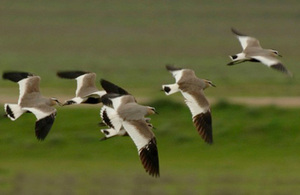Darwin award uncovers 'mystery' of rare bird decline
Darwin Initiative post-project increases understanding of the Sociable Lapwing's migration and threats

6 sociable lapwings in the steppes of Kazakhstan. Credit: Maxim Koshkin
The Sociable Lapwing is listed as Critically Endangered on the IUCN Red List, placing it among the 200 bird species worldwide most likely to become extinct in the near future. It breeds on open grassland in Russia and Kazakhstan and migrates south through Kyrgyzstan, Tajikistan, Uzbekistan, Turkmenistan, Afghanistan, Armenia, Iran, Iraq, Saudi Arabia, Syria and Turkey. Some early research highlighted the importance of the steppes of Kazakhstan for overwintering for the bird.
Responding to population decline
A Darwin Initiative main project started in 2006 in response to a steep drop in population, which was thought to have fallen by as much as 90% during the previous 20 years. The project focused on the wintering range in Kazakhstan, where it was thought that the low breeding success was contributing species decline. Through this project it became clear that the threats to the bird did not originate in Kazakhstan and instead were suspected to be linked to hunting on its migration route. A post project was funded to better understand the threats facing the survival of the Sociable Lapwing outside of Kazakhstan.
Delivering continued conservation support
The Post Project aimed to promote the conservation of the species across its migratory routes and wintering grounds. The post project worked with partners in all of the countries the bird travels across on its migration to wintering grounds. Through extensive negotiation, the project led the development of a Species Action Plan under the Agreement on the Conservation of African-Eurasian Migratory Waterbirds. This will help to tackle the key threats to this important species.
By building on the success of a main project, the post project built capacity by training students to obtain high quality data from the breeding grounds. The continued financial support received from the post project meant that conservation actions developed in the main project could be implemented during the post project.